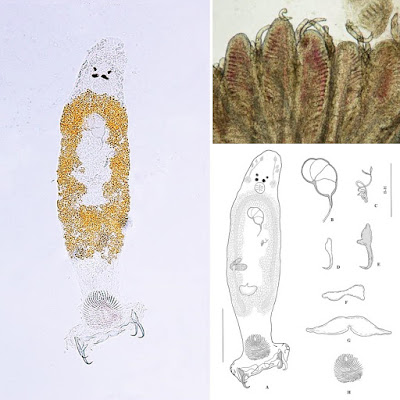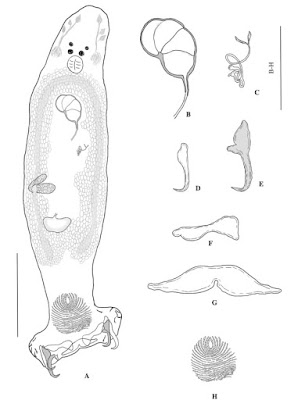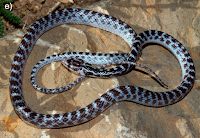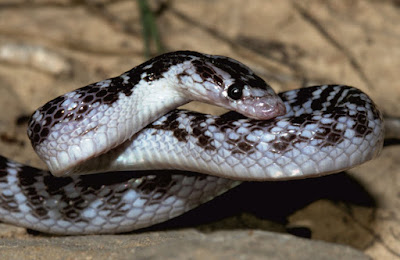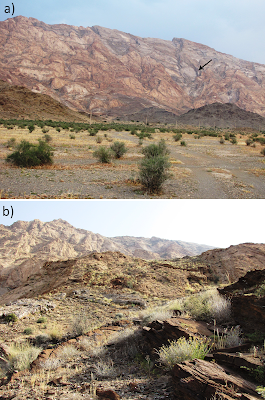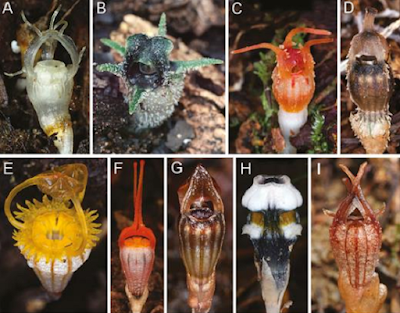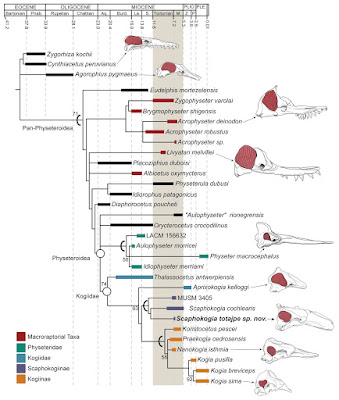[Most Recent Entries] [Calendar View]
Wednesday, April 22nd, 2020
| Time | Event | ||
| 2:03a | [Ichthyology • 2019] Jenynsia sulfurica • Molecular and Morphological Convergence to Sulfide-tolerant Fishes in A New Species of Jenynsia (Cyprinodontiformes: Anablepidae), the First Extremophile Member of the Family
Abstract Freshwater sulfide springs have extreme environmental conditions that only few vertebrate species can tolerate. These species often develop a series of morphological and molecular adaptations to cope with the challenges of life under the toxic and hypoxic conditions of sulfide springs. In this paper, we described a new fish species of the genus Jenynsia, Anablepidae, from a sulfide spring in Northwestern Argentina, the first in the family known from such extreme environment. Jenynsia sulfurica n. sp. is diagnosable by the lack of scales on the pre-pelvic area or the presence of a single row of scales, continuous or not, from the isthmus to the bases of the pelvic fins. Additionally, it presents a series of morphological and molecular characteristics that appear convergent with those seen in other fish species (e.g., Poeciliids) inhabiting sulfide springs. Most notably, J. sulfurica has an enlarged head and postorbital area compared to other fish of the genus and a prognathous lower jaw with a hypertrophied lip, thought to facilitate respiration at the air-water interface. Analyses of cox1 sequence showed that J. sulfurica has two unique mutations resulting in amino acid substitutions convergent to those seen in Poeciliids from sulfide springs and known to provide a physiological mechanism related to living in sulfide environments. A phylogenetic analysis, including molecular and morphological characters, placed J. sulfurica as sister taxa to J. alternimaculata, a species found in nearby, non-sulfide habitats directly connected to the sulfide springs. Thus, it can be inferred that the selection imposed by the presence of H2S has resulted in the divergence between these two species and has potentially served as a barrier to gene flow. Jenynsia sulfurica, new species Diagnosis The genus Jenynsia is subdivided into two subgenera, one containing five species only known from inland habitats in Brazil (Plesiojenynsia) and a more widely distributed subgenus including nine previously described species (Jenynsia). The new species herein described (Fig 1) presents the three synapomorphies considered by Ghedotti [1998] as diagnostic for the subgenus Jenynsia: (1) a modified sixth anal-fin ray segmented on its proximal quarter; (2) unsegmented on its distal quarter in adult males and (3) the vertically inclined proximal radials associated with the first six anal-fin rays in the gonopodium. Also, in the analyses under both, equal and implied weightings, the additional synapomorphies proposed by Aguilera et al. [2013] for the subgenus Jenynsia were recovered (i.e. character state 17–1; 47–1; 51–1 and 64–2; S1 Table). In the new species herein described, character 64 is reversed to state 0 (S1 Table). The new species is diagnosable from all other species of the genus by the absence of scales on the ventral surface of the body or the presence of a single row of scales, continuous or not, from the isthmus to the pelvic-fin bases (vs. completely scaled ventral surface of body in all species of Jenynsia; Fig 3). Additionally, J. sulfurica presents a unique coloration pattern, exhibiting eight to eleven irregular blotches along the mid-lateral surface of the body. These are formed by dark-brown chromatophores, ranging from rounded spots to vertical bars spreading up to three scales in depth (vs. different configuration pattern; Fig 1). Distribution: Jenynsia sulfurica is currently only known from Laguna La Quinta, which is part of a thermal system in the western flank of the Santa Bárbara hills, Santa Bárbara Department, Jujuy Province, Northwestern Argentina (Fig 5). It connects to the San Francisco River, tributary of the Bermejo River in the Paraná River basin. Conclusions: So far, fishes of only four taxonomic families were known to have representatives in freshwater sulfide springs: Poeciliidae, Cyprinodontidae, Rivulidae (all Cyprinodontiformes), and Synbranchidae (Synbranchiformes). Moreover, only six of these species are endemic to sulfide springs (i.e., Cyprinodon bobmilleri, Aphanius ginaonis, Gambusia eurystoma, Limia sulphurophila, Poecilia sulphuraria, and P. thermalis). Jenynsia sulfurica is the first species of the genus Jenynsia, and the only species within Anablepidae currently known to inhabit sulfide springs, a very extreme freshwater environment. Moreover, Jenynsia sulfurica is the first microendemism within the genus, being present only in a small sulfide thermal spring in Northwestern Argentina.Members of the order Cyprinodontiformes are in general highly tolerant to high temperatures, different concentrations of salinity, and a wide range of physicochemical environmental conditions, including environments with high concentrations of sulfide. In the genus Jenynsia, only a few studies were conducted to evaluate the tolerance of these fish to different environmental conditions, and almost all focused on J. lineata (= J. multidentata). This species is considered to be highly tolerant (e.g., euryhaline, eurythermic and euryoic), as it is commonly found to inhabit a wide range of abiotic conditions. Although there are no studies in the remaining species of the genus, it is possible that closely related species also show high tolerance to variation in different abiotic factors. This is in line with the pattern of diversity within the genus, where different species are found across drainages (i.e., in the absence of gene flow) rather than within drainages (i.e., in the presence of gene flow). Thus, Jenynsia sulfurica is, from an ecological and an evolutionary perspective, an interesting species that attests to the extreme conditions of H2S enriched environments. Gastón Aguilera, Guillermo Enrique Terán, Juan Marcos Mirande, Felipe Alonso, Sina Rometsch, Axel Meyer and Julian Torres-Dowdall. 2019. Molecular and Morphological Convergence to Sulfide-tolerant Fishes in A New Species of Jenynsia (Cyprinodontiformes: Anablepidae), the First Extremophile Member of the Family. PLoS ONE. 14(7): e0218810. DOI: 10.1371/journal.pone.0218810 | ||
| 2:39a | [Invertebrate • 2020] Pseudorhabdosynochus kasetsartensis (Monogenea: Diplectanidae) from the Cloudy Grouper Epinephelus erythrurus (Valenciennes) (Perciformes: Serranidae) in the lower Gulf of Thailand
Abstract Pseudorhabdosynochus kasetsartensis n. sp. is described from the gills of the cloudy grouper Epinephelus erythrurus (Valenciennes) caught in the lower Gulf of Thailand. The new species is distinguished from other species assigned to the genus by the structure of its sclerotised vagina which has a wide and prominent sclerotised trumpet, long, thin, coiled or curved primary canal, short secondary canal, and primary and secondary chambers that are blind extremities of the primary and secondary canals, respectively. This is the first species of Pseudorhabdosynochus Yamaguti, 1958 described from E. erythrurus and the first record of a species of Pseudorhabdosynochus in Thailand. Pseudorhabdosynochus kasetsartensis n. sp. Type-host: Epinephelus erythrurus (Valenciennes) (Perciformes: Serranidae). Type-locality: The lower Gulf of Thailand (...), October 2018. Site in host: Gills. Prevalence and intensity: 100% (30/30); mean intensity: 38 individuals/fish (1,140/30). Etymology: The species name honors Kasetsart University and the Kasetsart University Research and Development Institute, the institute that has funded our aquatic parasitology studies for many years. Chompunooch Saengpheng and Watchariya Purivirojkul. 2020. Pseudorhabdosynochus kasetsartensis n. sp. (Monogenea: Diplectanidae) from the Cloudy Grouper Epinephelus erythrurus (Valenciennes) (Perciformes: Serranidae) in the lower Gulf of Thailand. Systematic Parasitology. 97(1); 99–106. DOI: 10.1007/s11230-019-09899-z | ||
| 3:15a | [Herpetology • 2020] Persiophis fahimii • Additions to the Phylogeny of Colubrine Snakes in Southwestern Asia, with Description of A New Genus and Species (Serpentes: Colubridae: Colubrinae)
Abstract Reptiles are still being described worldwide at a pace of hundreds of species a year. While many discoveries are from remote tropical areas, biodiverse arid regions still harbor many novel taxa. Here, we present an updated phylogeny of colubrid snakes from the Western Palearctic by analyzing a supermatrix of all available global snake species with molecular data and report on the discovery of a new genus and species of colubrine snake from southeastern Iran. The new taxon, named Persiophis fahimii gen. et sp. nov., is nested within a clade containing Middle Eastern and South Asian ground racers (Lytorhynchus, Rhynchocalamus, Wallaceophis, and Wallophis). This species has a derived morphology including an edentulous pterygoid and occurrence of short and blunt teeth on the palatine, maxillae and dentary bones, an elongated snout and a relatively trihedral first supralabial scale that is slightly bigger than the second, and elongated toward the tip of rostral. We also report on the osteology and phylogenetic placement of several poorly studied colubrines: Hierophis andreanus (reassigned to Dolichophis) and Muhtarophis barani. Persiophis fahimii gen. et sp. nov. Diagnosis: For the genus and species, Persiophis fahimii is distinguished within the subfamily Colubrinae by a combination of distinct osteological characters, including the occurrence of vestigial teeth on the palatine; a thin, edentulous pterygoid; short and blunt teeth on the maxillae and dentary, occurrence of edentulous parts on the anterior and middle region of the maxillae; a fully fused basioccipital and basisphenoid; the occurrence of a highly oblique quadrate bone attached to the posterior tip of a somewhat elongated supratemporal. The genus and species are also distinguished within the subfamily Colubrinae by a combination of morphological characters, including an elongated snout; occurrence of a rostral scale that is visible from above and wedged between the internasals; a relatively trihedral first supralabial that is slightly bigger than the second and elongated toward the tip of rostral; 15 longitudinal rows of dorsal scales on midbody; and an edentulous pterygoid. Natural history: Our data on biology of Persiophis fahimii is based on the one specimen collected. The holotype was collected at elevation of 1,350 m ASL on a bare mountainside, while climbing on a vertical rocky wall, at late night (2.30 AM). The mountain is composed of Devonian limestone marbles, at the southeastern edge of the central mountains of Iran, ranging from 1,050 to 1,600 m ASL. Dominant vegetation on the plain in front of the mountain is Calligonum and annual forbs and grasses. At the base of the mountain, the vegetation changes to Calligonum and Ziziphus nummularia. At the type locality, the vegetation is dominated by sparse woody, thorny or aromatic shrubs, including Periploca sp. (Apocynaceae), Dichanthium sp. (Poaceae), Fagonia sp. (Zygophyllaceae), Ephedra foliata (Ephedraceae), Teucrium sp. (Lamiaceae), Lophochloa sp. (Poaceae), Lycium sp. (Solanaceae), Tribulus sp. (Zygophyllaceae), Pulicaria sp. (Asteraceae), Reseda sp. (Resedaceae), Heliotropium sp. (Boraginaceae), Gymnocarpos decander (Caryophyllaceae), Convolvulus sp. (Convolvulaceae), Heliantemum sp. (Cistaceae), and Diceratella persica (Apiaceae). Etymology: The genus name is a latinized noun in masculine gender derived from the Greek words “Persi-” (Persís) = Persia (old name of Iran) and “ophis” = serpent. The species is named after Dr. Hadi Fahimi, a young naturalist and herpetologist who dedicated his life to studying the biodiversity and conservation of reptiles and mammals of Iran. As a young nature lover, Hadi joined the rangers of the Department of Environment in Kerman province for two years and served partly in Khabr National Park where is close to the type locality of Persiophis fahimii. He was a Ph.D. student in IAU, Tehran, studying on the conservation of black bears in southeastern Iran, but sadly passed away in an aircraft crash in Dena Mountain in central Zagros in February 2018. We suggest the common name “Fahimi’s Ground Snake” in English for the new species. Conclusions: Here, we present new molecular sequence data and a new phylogenetic analysis of snakes, focusing primarily on Colubrinae from southwestern Asia. We find continued uncertainty in the placement of the enigmatic Turkish genus Muhtarophis based on osteological comparisons, despite strong support in the phylogenetic analysis. On the basis of the tree and morphology, we confidently reassign Hierophis andreanus from Hierophis to Dolichophis, hereafter referred to Dolichophis andreanus. Our morphological and molecular data also suggest a potential instance of convergent miniaturization in these Old-World racers. Finally, we report on the discovery of a new genus and species of ground snake, Persiophis fahimii, from southeastern Iran. Our data highlight the importance of broad phylogenetic sampling and ground-level field research to gather an accurate picture of global biodiversity, phylogenetic relationships, and evolutionary patterns in groups such as snakes. Mahdi Rajabizadeh, R. Alexander Pyron, Roman Nazarov, Nikolay A. Poyarkov, Dominique Adriaens and Anthony Herrel. 2020. Additions to the Phylogeny of Colubrine Snakes in Southwestern Asia, with Description of A New Genus and Species (Serpentes: Colubridae: Colubrinae). PeerJ. 8:e9016. DOI: 10.7717/peerj.9016 | ||
| 4:02a | [Botany • 2020] Phylogenetics of the Mycoheterotrophic Genus Thismia (Thismiaceae: Dioscoreales) with A Focus on the Old World Taxa: Delineation of Novel Natural Groups and Insights Into the Evolution of Morphological Traits
Abstract Thismia is a genus of > 80 mycoheterotrophic species characterized by a peculiar appearance and complex floral morphology. A significant proportion of the species and morphological diversity of Thismia has only been uncovered in the past two decades, and new discoveries continue to be made. Given that many new data have recently become available, and the most comprehensive taxonomic revision of the genus from 1938 addresses less than half of the currently known species, previous hypotheses for species relationships and infrageneric taxonomic classification in Thismia was in need of review. Extensive molecular phylogenetic studies of Thismia at the genus level have never been presented. We investigate the phylogenetic relationships of 41 species (and one variety) of Thismia from the Old World. Our study comprises 68 specimens (for 28 of which the data were newly generated), including outgroup taxa broadly representing Thismiaceae (= Burmanniaceae p.p. sensuAPG IV, 2016), and is based on two nuclear and one mitochondrial marker. We use maximum likelihood and Bayesian inference to infer relationships among the taxa. We also constructed a morphological dataset of 12 mostly floral characters, comparing these characters to hypotheses based on molecular evidence to identify putative synapomorphies for major clades and to discuss hypotheses regarding the evolution of structural traits in the genus. Our analyses indicate that the majority of currently accepted infrageneric taxa of Thismia are polyphyletic. We find support for the monophyly of the Old World group, in which we recognize five well-supported lineages (clades); the only New World species studied appears to be related to the Neotropical genus Tiputinia. Ancestral state reconstructions demonstrate that the evolution of most morphological characters was homoplastic, but we identify characters that provide each of the five clades of Old World Thismia with a unique morphological description. The geographical distribution of the species under study is also shown to be consistent with the major clades. Our investigation provides a phylogenetic basis for the development of a novel sectional classification of Thismia reflecting morphological and geographical traits. Keywords: floral traits, high-throughput sequencing, molecular phylogenetics, monocots, non-photosynthetic plants, South-East Asia Ekaterina A. Shepeleva, Mikhail I. Schelkunov, Michal Hroneš, Michal Sochor, Martin Dančák, Vincent Sft Merckx, Izai Abs Kikuchi, Sahut Chantanaorrapint, Kenji Suetsugu, Hirokazu Tsukaya, Shek S. Mar, Hong Truong Luu, Hong-Qing Li, Maria D. Logacheva and Maxim S. Nuraliev. 2020. Phylogenetics of the Mycoheterotrophic Genus Thismia (Thismiaceae: Dioscoreales) with A Focus on the Old World Taxa: Delineation of Novel Natural Groups and Insights Into the Evolution of Morphological Traits. Botanical Journal of the Linnean Society. boaa017. DOI: 10.1093/botlinnean/boaa017 | ||
| 5:04a | [PaleoMammalogy • 2020] Scaphokogia totajpe • A New Bulky-faced Pygmy Sperm Whale (Kogiidae) from the late Miocene of Peru
ABSTRACT The modern pygmy and dwarf sperm whales (Physeteroidea, Kogiidae) are remnants of a highly diverse group, which flourished in the Miocene oceans. Unlike their modern suction-feeding, deep-diving relatives, the past diversity of this family includes animals with disparate ecological habits. Here, we describe Scaphokogia totajpe, sp. nov., a new species of kogiid based on a well-preserved skull from the upper Miocene strata of the Pisco Formation, Peru. A phylogenetic analysis places S. totajpe as sister taxon of S. cochlearis and divides Kogiidae into two clades: the first including both species of Scaphokogia and the second including Kogia, Koristocetus, Praekogia, and Nanokogia. Similar to S. cochlearis, S. totajpe has a tubular rostrum with a hypertrophied mesorostral canal, a large supracranial basin, and a leftward deviated facial sagittal crest, but it differs by possessing a proportionately shorter rostrum, a reduced projection of the lacrimojugal between the frontal and the maxilla, and a flat occipital shield. The cranial morphology of Scaphokogia indicates that the extent of the nasal complex was greater than in modern kogiids. Furthermore, the overall rostrum shape and the reconstructed muscle insertion sites indicate that Scaphokogia retained some plesiomorphic features related to a more generalist ecology. Inclusion of S. totajpe into the context of the Pisco Formation indicates that during the late Miocene, the Peruvian coastal system was a hot spot for the diversification of physeteroids, with at least four species coexisting. Finally, Scaphokogia totajpe highlights a late Miocene diversity peak for sperm whales in the global oceans, before the Pliocene odontocete turnover. Aldo Benites-Palomino, Jorge Vélez-Juarbe, Rodolfo Salas-Gismondi and Mario Urbina. 2020. Scaphokogia totajpe, sp. nov., A New Bulky-faced Pygmy Sperm Whale (Kogiidae) from the late Miocene of Peru. Journal of Vertebrate Paleontology. e1728538. DOI: 10.1080/02724634.2019.1728538 | ||
| 8:26a | [Botany • 2020] Hohenbergia ituberaensis (Bromeliaceae) • A New White-flowered Species from Bahia, Brazil
Abstract We describe a new species of Hohenbergia (Bromeliaceae) from Brazil, Hohenbergia ituberaensis, a rare species, so far only known from Ituberá municipality, Bahia State, in an area of the Atlantic Forest. The species is similar to H. stellata, presenting a pinkish inflorescence, congested and non-divided branches, pinkish and large floral bracts hiding the sepals, spatulate petals with a slightly reflexed apex. However, it differs by the white petals, as a diagnostic characteristic. The type specimen was collected in a small forest fragment and here this species is categorized as Vulnerable. Additionally, we compared this new species to Hohenbergia belemii and H. capitata, which are also similar to H. stellata, due to the red/pinkish characteristics of the branches, with large flowers and well-developed floral bracts. An illustration, an occurrence map, taxonomic comments and a table comparing the main characters of these four species are provided. Keywords: Atlantic Forest, Bromelioideae, Hohenbergia stellata, Monocots Brayan Paiva Cavalcante, Everton Hilo De Souza, Leonardo M. Versieux and Adriana Pinheiro Martinelli. 2020. Hohenbergia ituberaensis (Bromeliaceae): A New White-flowered Species from Bahia, Brazil. Phytotaxa. 439(2); 119–126. DOI: 10.11646/phytotaxa.439.2.2 |
| << Previous Day |
2020/04/22 [Calendar] |
Next Day >> |
